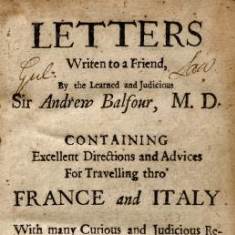
Biography
Andrew Balfour was born in Fife on 18 January 1630, the fifth and youngest son of Sir Michael Balfour. Balfour grew up in his family seat, Balfour Castle, and received his early education at the parish school. He studied philosophy at St Andrews and graduated MA in 1650. Balfour, encouraged by his brother, probably visited Oxford and London before travelling to France in 1657, primarily to see the gardens of the duc d’Orleans at Blois. It was at Blois that Balfour befriended Robert Morison, who would play an important role in Balfour’s botanical career. Balfour lived in Paris, studying medicine, before graduating MD at Caen on 20 September 1661.
Balfour then travelled to London where he rubbed shoulders with the most famous physicians of the day. He was presented to Charles II, who recognized his potential and appointed Balfour as tutor to the young earl of Rochester. Balfour accompanied Rochester on a grand tour from 1661 to 1664, during which he gathered a magnificent collection of medical and natural history books, curiosities, and other specimens. In 1667, Balfour returned to St Andrews where he practiced as a physician, continued collecting botanical samples and experimented in science and medicine.
By 1670, Balfour was living in Edinburgh where he established a private practice. In Edinburgh, Balfour set up a physic garden with Robert Sibbald, a distant cousin. This garden, near Holyrood Abbey, was enhanced by specimens sent to Balfour by Morison. Balfour appointed James Sutherland as the first curator of the garden, which would later evolve into the Royal Botanic Gardens of Edinburgh. Balfour convinced Edinburgh University to take the garden over as an adjunct to the medical school. Sutherland’s catalogue of 1684 indicates that the garden had about 2,000 non-indigenous species.
Balfour was a prominent member of Edinburgh’s learned society and opened his own private museum, gallery and library. He was active in establishing professorial chairs at Edinburgh University and, with Sibbald, was a key figure in founding the Royal College of Physicians of Edinburgh in 1681. Balfour authored the parts on materia medica in the first Edinburgh Pharmacopoeia, published in 1685. He died suddenly while walking along the street in January 1694. His wife predeceased him and they had one known surviving son, Michael Balfour. Balfour was buried in Greyfriars kirkyard. After his death, Balfour’s vast collection was dispersed and sold. In 1699, Sibbald published an account of Balfour’s life, Memoria Balfouriana.
Notable Achievements
Balfour was founding member of the Royal College of Physicians of Edinburgh.
Balfour was made a baronet and physician-in-ordinary to Charles II in Scotland in 1681.
Balfour was elected president of the Royal College of Physicians of Edinburgh in 1685.
He was a key figure for the first edition of the Edinburgh Pharmacopoeia (1685).
Key Publications
- Letters Written to a Friend (1700)



